Joy Neal Kidney's Blog, page 30
October 30, 2023
A Welcome Guest Post about the Leora Stories
She’s done it again! Only this time it’s even better!
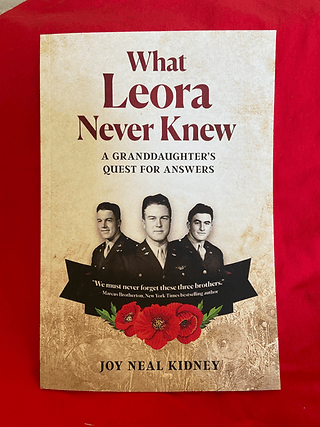
I refer to the latest book by Joy Neal Kidney, the keeper of her family’s history. My copy arrived in my mailbox yesterday, and although I had already read the pre-publication manuscript, I immediately wanted to re-read it.
This new work, titled What Leora Never Knew: A Granddaughter’s Quest for Answers, is a companion book and sequel to her first book, Leora’s Letters: The Story of Love and Loss for an Iowa Family during World War II.

Whereas the earlier work recounts the true story of how five brothers served during the war, only two of whom came home, this latest work tells, as famed radio commentator Paul Harvey would have said, “the rest of the story.” It reflects Kidney’s years of hard work and her relentless quest to uncover exactly what happened to those three brothers. It is heavily documented and illustrated, relating all the things the grieving mother, Leora, never knew about her sons’ fate. Kidney has demonstrated how relentless digging can reveal amazing family history.
I now am blessed to have the entire set of Kidney’s family history. Although they were not written in strictly chronological order, here are their titles in the order the events they describe occurred:
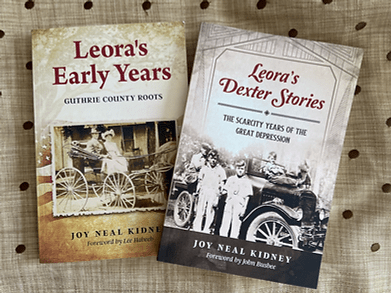
Leora’s Early Years: Guthrie County Roots
Leora’s Dexter Stories: The Scarcity Years of the Great Depression
Leora’s Letters: The Story of Love and Loss for an Iowa Family during World War II
What Leora Never Knew: A Granddaughter’s Quest for Answers
Although any one of them can stand on its own, the whole series is even better when read in conjunction with the others.

It is also helpful to know about the author. Joy Neal Kidney is a native of Iowa, the oldest granddaughter of Leora, of whom she writes. She graduated from the University of Northern Iowa. Married to Guy, a Vietnam War veteran and former air traffic controller, she lives in central Iowa, where she writes and speaks about her books and family history. She is the recipient of the 2021 Great American Storyteller Award, bestowed by Lee Habeeb, founder and host of the national Our American Stories radio program, for which she also is a frequent contributor.
I had the good fortune to interview Joy for my blog, and you can access the reports of them at the following links: https://www.dennislpeterson.com/post/joy-neal-kidney-keeper-of-family-stories-shares-more (Part 1) and https://www.dennislpeterson.com/post/the-keeper-of-family-history-an-interview-with-joy-neal-kidney-part-2.
You can also learn more about Joy and her books on her own website at https://joynealkidney.com/.
I strongly encourage my readers to become her readers, too. She’s a great writer with great stories about a great American family.
 To get acquainted with generous author Dennis Peterson, please visit his website.
To get acquainted with generous author Dennis Peterson, please visit his website.
October 28, 2023
Smorgasbord Book Promotions – New Book on the Shelves – What Leora Never Knew: A Granddaughter’s Quest for Answers (Leora’s Stories) by Joy Neal Kidney

Delighted to share the news of the latest release by Joy Neal Kidney in her biographical family based series. What Leora Never Knew: A Granddaughter’s Quest for Answers (Leora’s Stories)

About the book
Five brothers served. Only two came home.
What Leora Never Knew: A Granddaughter’s Quest for Answers is Joy Neal Kidney’s journey of research and remembrance, and the companion book to Leora’s Letters: The Story of Love and Loss for an Iowa Family During World War II.
Joy Neal Kidney’s new book, What Leora Never Knew: A Granddaughter’s Quest for Answers, masterfully captures the essence of “The Greatest Generation” through her family lens. – John Busbee, The Culture Buzz
We must never forget these young men who served our nation and who paid the ultimate sacrifice with their lives. – Steve Snyder, author of Shot Down: The True Story of Pilot Howard Snyder and the Crew of the B-17 Susan Ruth
What Leora Never Knew is a part of the Leora’s Stories series, published jointly with Joy Neal Kidney and Legacy Press Books. http://www.legacypressbooks.org
Head over to buy the book: Amazon US – And: Amazon UK
Also by Joy Neal Kidney
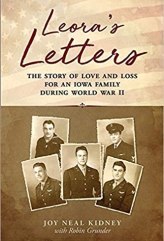

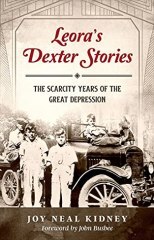
One of the recent reviews for Leora’s Early Years
DTH 5.0 out of 5 stars Heart Warming/Heart Wrenching Reviewed in the United States“Leora’s Early Years” is an excellent read for young and old alike. Joy Neal Kidney shows readers what life was like many years ago – during the 1800’s. How families survived back then is amazing. She lets readers see how they – moms, pa’s and kids – worked together. Older children helped with the younger ones, young boys and girls worked in the fields, milked cows, took care of the other animals – and Leora tended to her chickens and sold eggs. How the women survived back then with bearing so many children, moving around from farm to farm, keeping up with all they had to do – and without the conveniences we have today – is unbelievable.
Joy Neal Kidney brings to life her ancestors as they moved around in Guthrie County and beyond during the 1800’s, the days of the horse and buggy, the one-room school house, and the love they shared in working together to make everything possible during their lives.
Joy Neal Kidney is to be admired for preserving the family stories and pictures from the early days, putting them all together in this great book, and giving all of us the opportunity to read and see everything in this great book, “Leora’s Earl Years.” I give it a five -star rating.
Read the reviews and buy the books: Amazon US – And: Amazon UK – More reviews: Goodreads – Website: Joy Neal Kidney – Facebook: Joy Neal Kidney Author – Twitter: @JoyNealKidney – Instagram: Joy Neal Kidney

About Joy Neal Kidney
Joy Neal Kidney is the oldest granddaughter of Leora Wilson, who lost three sons during WWII and was widowed, all during a three-year period. Through the decades, Joy helped take Memorial Day bouquets to the graves of those three young uncles, not knowing that only one of them is buried there–until decades later, after the death of her courageous little Grandma Leora.
Joy became a writer in order to tell her stories.
She and her husband, Guy (an Air Force Veteran of the Vietnam War and retired Air Traffic Controller) live in central Iowa. Their son is married and they live out-of-state with a small daughter named Kate.
A graduate of the University of Northern Iowa, Joy has lived with fibromyalgia for two dozen years, giving her plenty of home-bound days to write blog posts and books, working with research from decades earlier.
All of the “Leora books” tell stories about world and national events reaching into the American Heartland–westward expansion, two world wars, pandemics, how mental health issues were handled, the Great Depression, and surviving great personal losses. But they are hopeful as well.
Thank you for dropping in today and I hope you will be leaving with some books.. Sally.
October 27, 2023
Generosity: Marcus Brotherton, New York Times bestselling author
I’ve been a fan of bestselling Marcus Brotherton‘s books for years, including books I didn’t realize he’d ghostwritten or he’d been involved in writing.
Earlier this year, when I read his masterful A Bright and Blinding Sun, I noticed that I’d featured several other favorite books with his fingerprints on them. (See below)
Ordinarily I share my blog posts on other social media sites, including LinkedIn. When I posted the one about A Bright and Blinding Sun, the author noticed it, thanked me for sharing about the book, and even asked to connect with me there. Later this year, I read and reviewed his compelling new WWII historical novel, The Long March Home, coauthored with Tosca Lee.
I almost didn’t ask whether he’d be willing to write a blurb for What Leora Never Knew, but I’m glad I did, sending him a short summary and list of chapters.
This generous author answered, “Sure!”
Marcus asked to see the pdf of the manuscript, which I emailed to him. A few days later he sent a simple but powerful sentence.
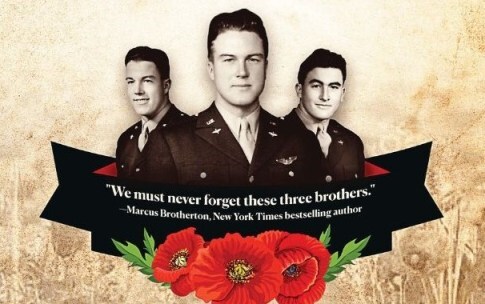
What a generous encouragement by a well-known author.
Here are other outstanding books I’d read earlier:
Marcus Brotherton contributed substance and line edits to Adam Makos’s A Higher Call: An Incredible True Story of Combat and chivalry in the War-Torn Skies of World War II.
He also wrote Blaze of Light, about Gary Beikirch, a Green Beret Medic in Vietnam and recipient of the Medal of Honor.
 Gary Beikirch (1947-2021) and Marcus Brotherton in 2019
Gary Beikirch (1947-2021) and Marcus Brotherton in 2019Gary Sinise’s Grateful American was written with Brotherton’s expertise.
 Marcus Brotherton and Gary Sinise
Marcus Brotherton and Gary SiniseAlso Marcus was a writing partner on Adam Makos’s incredibly poignant Korean War story, Devotion, which I read and reviewed (Amazon, Goodreads, and BookBub). All of these books are so compelling.
Please check out Marcus Brotherton’s website. What a legacy of significant stories!
October 25, 2023
Book-Launch Un-Shindig
Five brothers served. Only two came home.
Only one is buried at home. I didn’t know that until my mid-40s, after Grandma Leora died. Having helped with Memorial Day flowers for three graves all those decades, I had to find out what happened, why one is buried overseas, and why one has never been found.
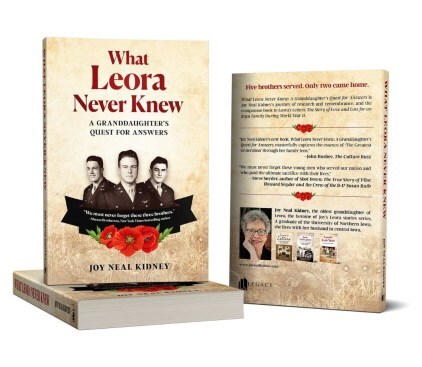
What Leora Never Knew: A Granddaughter’s Quest for Answers is my journey of research and remembrance, a companion book to Leora’s Letters: The Story of Love and Loss for an Iowa Family During World War II.
I’ve never felt well enough to have a peppy book-launch party, not even to organize a chipper launch team. My fibromyalgia symptoms have become more abundant, prompting me to send regrets to invitations to talk about Grandma Leora’s stories. (I said yes to one in Perry next month, likely my last, since two books have so many stories from that area.)
But some of you just might fancy un-shindig cheerleading for the newest Leora book, which I’d be so grateful for. Here are some free ideas:
You could ask your library to get a copy of What Leora Never Knew: A Granddaughter’s Quest for Answers.You might read it (100 photos in this one) and write a short review on Amazon, Goodreads, BookBub, or even on Facebook.You could post a selfie with the book on social media!You might tell someone about about the Wilson family of Dallas County, Iowa.But if you’d like to actually have a copy of your own, What Leora Never Knew is always available on Amazon. Autographed copies are at Beaverdale Books (515-279-5400
beaverdalebooks@gmail.com) in Des Moines, the Machine Shed Restaurant in Urbandale, and Off the Rails Quilting in Bondurant (515-967-3550) info@offtherailsquilting.com. Beaverdale Books and Off the Rails Quilting both offer shipping.
The ebook has been uploaded but still doesn’t show that it’s “live.” Soon!
Thank you for joining me for this latest Book-Launch Un-Shindig!
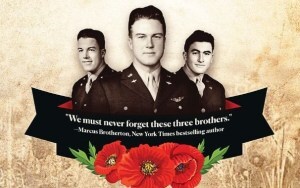
October 23, 2023
Just Out: What Leora Never Knew
What Leora Never Knew
A Granddaughter’s Quest for Answers
The day the second atomic bomb was dropped, a telegram was delivered at the Perry, Iowa home of Clabe and Leora Wilson. Two of their sons were Missing in Action, one in Europe, one in the South Pacific. I was a toddler underfoot that day at my grandparents’ home with my mother, who opened the telegram that announced the shocking news that Junior, her youngest brother, had been killed near his air base in Texas that morning. The engine of his P-40 threw a rod and exploded.
All five Wilson brothers served in World War II. Only two came home.
Only after courageous Grandma Leora died in 1987, I learned that Junior is the only one buried in the Perry cemetery. All those childhood years of tagging along with Grandma, my mother and her sister, on Decoration Day, we’d arranged bouquets for all three brothers.
What happened to them? Needing to find out, I read dozens of books, requested the Wilson brothers’ casualty reports, joined WWII reunion groups, and wrote dozens of letters, logging each in a spiral notebook. I located the man who, as a fellow pilot, accompanied Junior’s casket to Iowa and stayed with the grieving family through the funeral.
Danny Wilson’s P-38 crashed in the snowy Alps. The casualty records reveal details of his poignant first burial. The care, thoroughness, and dignity given his remains as they were identified, moved, and reburied are especially compelling. Dan’s best friend from overseas stopped here to see Mom and me, bringing his scrapbook, sharing photos and stories. The mayor of the city where he was first buried sent a copy of the town history. On page 41, is the first photo the family had ever seen of Dan’s wrecked Lightning.
Dale Wilson’s B-25 was shot down off New Guinea. The bomber and crew of six have never been found. When an eyewitness to the crash at sea learned that Dale’s diary had been removed by the Quartermaster Depot in Kansas City, he photocopied his own combat diary for me. I’m still in contact with relatives of some of the bomber crew.
I’d grown up with the shadows
During the years of research and writing about these terrible losses, I realized I’d grown up with the shadows of those three brothers. Taking on the responsibility of keeping their memories alive, I corresponded with the curator of a New Guinea museum, and with the veteran whose burden it had been to return letters from New Guinea marked “Missing in Action,” as well as remembering–with Mom and Aunt Darlene–all three brothers at the Perry cemetery each Decoration Day.
What Leora Never Knew: A Granddaughter’s Quest for Answers is my own journey of remembrance.
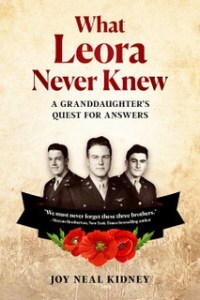
October 20, 2023
John Quincy Adams Reynolds, Civil War Veteran
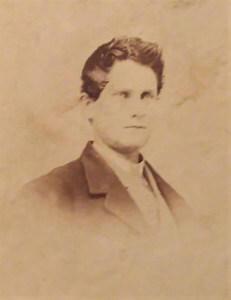
I, John Quincy Adams Reynolds, was born into a Quaker family near Westville, Indiana in 1844. My parents had moved from their old country home in North Carolina–in protest against the attitude of the South on slavery.
When I was 16, war broke out. I lied about my age when I enlisted, but my father showed up at camp and ordered me home. I was part of home guards for two years, but enlisted for real in late 1863 with the 12th Indiana Cavalry.
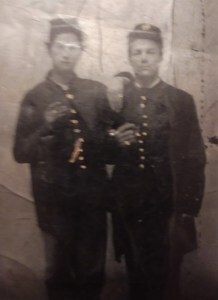 J.Q.A. is on the left
J.Q.A. is on the left Civil War discharge papers of J.Q.A. Reynolds.
Civil War discharge papers of J.Q.A. Reynolds.After being discharged in late 1865, I worked on farms until two friends and I loaded a covered wagon and made our way west to Iowa. We arrived at a relative’s home 2 ½ miles north of where Dexter is now in October 1867. There was no town yet.
I married Sarah Emily Pugh, youngest daughter of James and Eleanor (Lank) Pugh, pioneers, having arrived in Dallas County in 1856. Before our marriage, Sarah taught school at Guthrie Switch (now Menlo). We later moved to the old Pugh farmstead north of Dexfield Park, where our children were born. The oldest two, Ernest and Julietta, started school across the road in the Hickory Grove country school.
 Sarah Emily (Pugh) Reynolds
Sarah Emily (Pugh) ReynoldsEdwin H. Conger connection
We moved into the town of Dexter in 1891, where our youngest son Conger was born. Conger was named for Edwin H. Conger, who also came to Dexter after serving in the Civil War. Edwin Conger became Treasurer of Dallas County, State Treasurer of Iowa, then a State Representative to the U.S. Congress.
We wrote Mr. Conger to tell them we had named our son after him. He sent young Conger Reynolds a $10 bill, which was his main treasure for many years.
In 1901, Edwin Conger, who had been appointed minister to Brazil, then to China, returned to Dexter “like a conquering hero.” He spoke on Decoration Day under trees next to the Methodist church. Afterwards, we went up to the platform so that my son could meet the famous man he’d been named for.
Son, Conger Reynolds
Nowadays I’m known more for being the father of Conger Reynolds. He wasn’t born until I was 48 years old. Since he was a rather thin and sickly child, we were advised to move to a milder climate. But after a year or so in California, we moved back to Dexter where all three children finished their schooling.


After Conger graduated in 1908, he attended Drake University in Des Moines for a year, then studied at the University of Iowa. He worked all sorts of jobs, including maintenance work in exchange for a room, peddling stereopticons door to door on a bicycle, and selling Collier’s magazine subscriptions by reaching rural areas on a horse.
 1912 Phi Beta Kappa key of Conger Reynolds
1912 Phi Beta Kappa key of Conger ReynoldsHe graduated Phi Beta Kappa in 1912 and is credited with founding the School of Journalism at the University of Iowa. He did some newspaper reporting in Des Moines before enlisting in WWI. Before being sent overseas, he married Daphne Goodenough on Christmas Day 1917.
My son was an intelligence officer for the press section of the American Expeditionary Forces in France. The Dexter Museum has a picture of him in uniform, and also the stamp he used to censor outgoing articles from the press office. He remained in France after the war as managing editor of the Paris edition of the Chicago Tribune.
Later, Conger was assigned as vice-consul to Nova Scotia, then vice-consul and later consul in Stuttgart, Germany. Specializing in trade promotion, he eventually became director of public relations for Standard Oil, from which he retired in 1955.
After retirement, Conger moved to Washington, DC, to serve in the US Information Agency, and to work with the Eisenhower administration in launching the People-to-People program for international understanding.
——–
My son’s letters papers have been collected by the University of Iowa, but his granddaughter, Linda Lyon, has also donated pictures of him and other items to the Dexter Museum.

I am proud that my son loved his hometown. He returned in the 1950s for a class reunion, to take pictures and remember, and probably to visit his mother’s and my graves. Conger wrote our obituaries and brought his family home to Dexter for our funerals.
Known as J.Q. Reynolds, I was a member of Dexter’s I.O.O.F. Lodge, also the G.A.R. post at Redfield while farming north of Dexter. After we moved to town, I joined the Dexter post.
For my funeral, members of the Redfield G.A.R. post, including their buglers, came to Dexter to form a guard with Dexter Civil War veterans. They made a procession to the cemetery, fired the last salute, and sounded “Taps” as my coffin was lowered into the Dexter Cemetery in 1930 four months before my beloved wife joined me.
From memoirs of Conger Reynolds and the Centennial History of Dexter.
Phi Beta Kappa at the University of Iowa
October 18, 2023
Dad’s First Tractor
During World War II, the production of new cars, tractors, farm machinery and other items were converted to *war production. When veterans of World War II were discharged from the military, those who wanted to farm were given certificates so they could buy new equipment.
Most veterans, having served several years, including Dad, had a certificate for a new tractor, but no money to buy one. His Uncle M.M. Neal offered to buy the certificate for enough to purchase a used tractor, so Uncle Maurice bought a brand new tractor and Dad bought his first one, an F-20, which he kept in use for several decades.
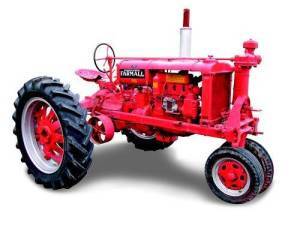
Living with farm equipment every day, we never thought about taking photos of them. I wish we had. Dad’s Farmall F-20 never looked this spiffy. I remember it a faded red with a sickle mower attached to keep weedy areas neat. It also powered the elevator which sent “square” bales of hay from the hayrack to the haymow. (So-called square bales are shaped like large bricks.)
Here are Dad’s other tractors (2019 post).
*Note: The MACR (Missing Air Crew Report), received from the National Archives on microfiche, listed the Installed Weapons of the P-38L in which Lt. Daniel Wilson lost his life. Three of them were built by Colt (a well-known firearms manufacturer), one by International Harvester (farm machinery), and one by Frigidaire (refrigerators).
Rabbit Trail: Allis-Chalmers was a manufacturer well suited for government contracts. During the 1930s, the Public Works Administration bought seven hydraulic turbines for the Hoover Dam project. During both world wars, the company made engines, weapons, electrical controls for ships, aircraft engine components, shells, and tracked vehicles. Allis-Chalmers also produced uranium-processing and research equipment for the Manhattan Project.
One more tractor story!
October 16, 2023
Catching Mumps Could be Deadly
Mumps is a contagious disease caused by a virus that spreads from person to person. Typical symptoms include swollen salivary glands, headache, muscle aches, fatigue and a fever. Mumps can also affect organs, including the brain, pancreas, testicles or ovaries. This usually only occurs in adolescents and adults, but once a person has had the disease, he is immune for life.
1914 – Newlyweds Clabe and Leora Wilson
The morning of the wedding of Leora Goff and Clabe Wilson, Leora felt a little swelling on her neck and jaw. Mumps was making the rounds of their Wichita, Iowa, neighborhood. Leora’s parents thought she’d had mumps as a baby. Clabe’s mother thought he had, too, but he came down with them a couple of weeks later. Three of Leora’s brothers also caught them. Mumps was the reason their neighbors cancelled a planned “chivaree” for the newlyweds–a noisy teasing on the wedding night or shortly afterwards.
1919 – Wayne Goff
 Wayne Goff, still in France with the 88th Division, spent his 25th birthday (February 24, 1919) in a mumps ward at Houdelainecourt, where he reported the hospital had a full house.
Wayne Goff, still in France with the 88th Division, spent his 25th birthday (February 24, 1919) in a mumps ward at Houdelainecourt, where he reported the hospital had a full house.
1924 – Tessie Goff
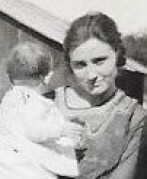 Tessie Goff with baby Maxine
Tessie Goff with baby MaxineThe summer of 1920, Jennings Goff (who had also served with the 88th Division) married Tessie Sauvago. Baby Maxine was born the next year, and Merrill three years later. Baby Merrill was four days old when his young mother died of mumps. He also came down with them, and Maxine–not quite three–caught chicken pox. Merrill was nursed back to health by Tessie’s folks near Wichita, in Guthrie County, while Jennings and little Maxine stayed in his family’s Victorian home in Guthrie Center.
1943 – Delbert Wilson
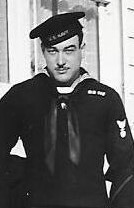 In April, the USS Achelous sailed with a convoy bound for North Africa–without Delbert Wilson, son of Clabe and Leora. Mumps. His next half dozen letters home were sent from the Naval Hospital at Norfolk, Virginia.
In April, the USS Achelous sailed with a convoy bound for North Africa–without Delbert Wilson, son of Clabe and Leora. Mumps. His next half dozen letters home were sent from the Naval Hospital at Norfolk, Virginia.
“I’ve been in this damn place for six days. Seems more like six weeks. Yea, I’ve got the mumps–don’t feel so bad, though. My temperature is about normal so I get a regular meal–which means a lot in a place like this. I have about week to go here at least before they will even consider turning me loose. They keep you in bed all the time it is not absolutely necessary to get up. They bring everything to you–meals, bath, etc.”
The swelling under his under his jaw was going down, but it still looked like he had a double chin. Delbert was in the ward for acute cases, with several new ones arriving.
After Del got out of the hospital, his ship had sailed without him.
—–
These days, children and adults don’t get mumps anymore. A mumps vaccine was developed in 1967. It was licensed in the United States in 1971 as a combined measles, mumps, and rubella (MMR) vaccine.
When was the last time you heard of anyone suffering with mumps?
October 13, 2023
See Jane Dance! by Jolene Stratton Philo
Jolene Philo’s third delightful “See Jane” book has just been published. This one includes dancing–square dancing! Check it out!

It’s New Year’s Day in the small town of Little Missouri, South Dakota, and Jane’s year is already off to an eventful start. She begins the day with the discovery of a body, setting off a murder investigation that will test the limits of her courage. Soon she’s juggling not only murder, but also the addition of four squirmy kindergarteners to her lively country school classroom.
Thanks to weekly square dance lessons paid for by her mother, the town switchboard operator, and the school janitor in an effort to kick-start her romantic life, she’s also fending off eligible bachelors right and left. As the snow piles up and the town gossip hits a feverish pitch, Jane and the sheriff must race against time to find a killer who’s dancing too close for comfort.
My thoughts: Stumbling upon a murdered man, a pseudo romance, and two women going halvsies to pay for Jane Newell’s square dance lessons–what else could happen to a spunky first-year teacher during a South Dakota winter.
Oh, there’s also dead cattle, a Valentine party at school, including the kapow king of kindergarten, non-skid pancakes with a side of gossip with an elderly neighbor, and a switchboard operator who keeps everyone informed. The pseudo romance? To cover up Jane’s involvement in solving the murder.
Another delightful West River Mystery, with a recipe at the end.
See Jane Dance! by Jolene Stratton Philo.
Who is Jolene Philo?
 “Before I became an author, I taught elementary school for 25 years. 7 of those years were spent in northwestern South Dakota. Our first child was born while we lived there, and our experiences with him resulted in 6 books for the special needs community.
“Before I became an author, I taught elementary school for 25 years. 7 of those years were spent in northwestern South Dakota. Our first child was born while we lived there, and our experiences with him resulted in 6 books for the special needs community.
“My fiction series, West River Mysteries, draws heavily on my years as an Iowan who landed in cowboy country, who taught country school, and who was adopted and cared for by the locals in the tiny town where we lived.”
Here is Jolene’s Amazon Author Page.
Earlier post about See Jane Run! and See Jane Sing!
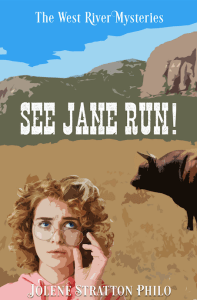

October 11, 2023
The Landlord’s John Deere A
When the Wilson family became tenant farmers near Minburn, Iowa, the spring of 1939, they hadn’t had a car since late 1934. (That was the Model T truck which became their “roadster“–and is on the cover of Leora’s Dexter Stories: The Scarcity Years of the Great Depression.)
Their son Donald was in the Navy, aboard the crew of the USS Yorktown (CV-5). Four sons moved to the farm with Clabe and Leora. Delbert had already served his four years enlistment in the Navy. Dale graduated from Dexter High School that May. Danny and Junior were in high school. Dale, Danny, and Junior had never had a chance to learn to drive.
The landlord was delighted with all those big sons to help farm. He had an old truck but he farmed with horses.
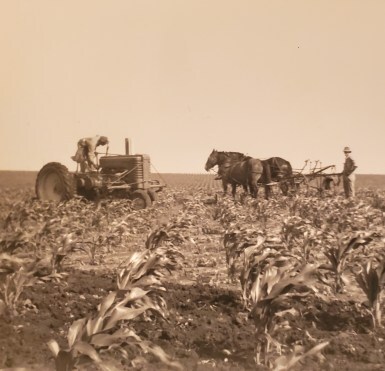 One of the Wilson brothers cultivated with the tractor, while his father’s cultivator was pulled by horses. Minburn, Iowa, 1942
One of the Wilson brothers cultivated with the tractor, while his father’s cultivator was pulled by horses. Minburn, Iowa, 1942By 1941, he had bought a John Deere A tractor, which the brothers enjoyed learning to drive and take care of it. Then the war broke out.

Delbert rejoined the Navy and Dale enlisted in the Army Air Force to become a pilot. In this 1942 photo, Danny Wilson is cultivating corn. Their mother Leora is at left, and Junior behind the tractor.
A year later, Junior wrote one of his brothers in the military that the John Deere was “in its summer dress,” meaning the cultivator. Before Junior left for the AAF, Clabe finally got to drive the tractor.
The John Deere Model A was the first true row crop tractor and the first tractor to come from the factory in Waterloo, Iowa, with rubber tires. These John Deeres were called “Johnny poppers” because of their distinctive sound.



